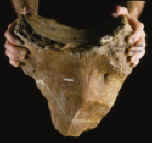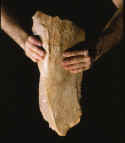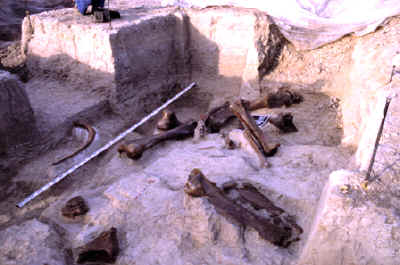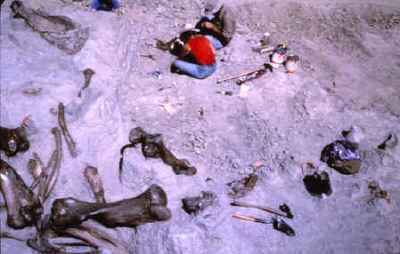
TAKEN FROM PICTURE
#11 IN THE CLOVIS SLIDE SET
CLICK ON PICTURE FOR LARGE IMAGE
LANGE - FERGUSON MAMMOTH KILL SITE
EXCAVATION
PICTURE
CREDIT--ARCHEOLOGY LABORATORY, CENTER FOR WESTERN STUDIES, AUGUSTANA
COLLEGE, DR. ADRIEN HANNUS
This
picture was taken in 1981 and shows three excavators working in the main
bone bed at Lange-Ferguson. Excavation of this site began in 1980 and
continued into 1984. Bone beds are the most difficult to excavate. One
problem is the organic material begins to deteriorate when exposed to the
air. The bones require special chemical treatment to preserve them. They
also need special handling for transport to a storage facility and the
larger specimens are encased in plaster jackets.
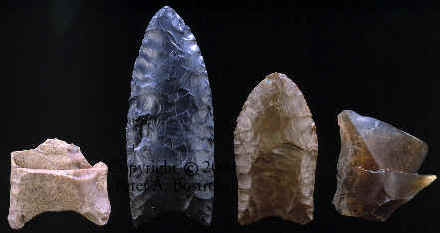
CLICK ON PICTURE FOR LARGE IMAGE
CLOVIS POINTS & CUTTING FLAKE
LANGE - FERGUSON SITE
ARCHEOLOGY LABORATORY,
CENTER FOR WESTERN STUDIES, AUGUSTANA COLLEGE COLLECTION
These
three Clovis points and one flake are the only stone artifacts found with
the two mammoths on the Lange - Ferguson mammoth kill site. The
translucent amber flake to the right could have been used for cutting small pieces of the
meat.
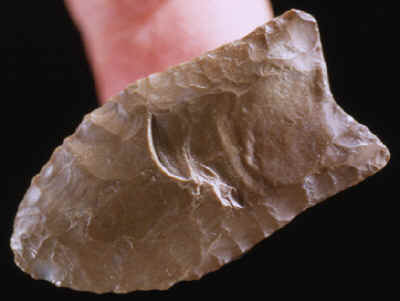
CLICK ON PICTURE FOR LARGE IMAGE
CLOVIS POINT
LANGE - FERGUSON SITE
ARCHEOLOGY LABORATORY,
CENTER FOR WESTERN STUDIES, AUGUSTANA COLLEGE COLLECTION
This is
the smallest projectile point that was found during the excavation of the
Lange - Ferguson Mammoth Kill site. It has been extensively resharpened to
it's current length of only 1 1/2 (38 mm) inches. When Clovis spear points
became damaged from impact fracturing and edge wear from cutting they were
resharpened until they were eventually used up. This Clovis point has been reduced to no more than half its original size and probably would have been discarded
before any more resharpening.
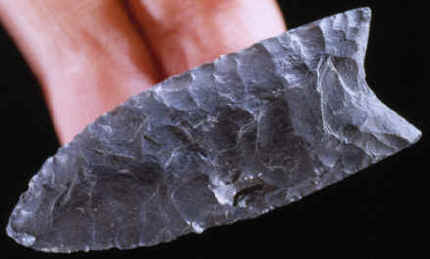
CLICK ON PICTURE FOR LARGE IMAGE
CLOVIS POINT
LANGE - FERGUSON SITE
ARCHEOLOGY LABORATORY,
CENTER FOR WESTERN STUDIES, AUGUSTANA COLLEGE COLLECTION
This
is the largest Clovis point that was found during excavation of the Lange
- Ferguson mammoth kill site. It was probably resharpened at least one or
more times. This spear point is made of a black opaque chert and measures
2 1/8 (54 mm) inches long.
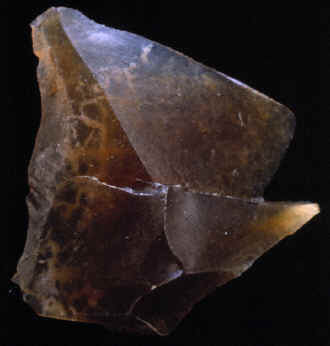
CLICK ON PICTURE FOR LARGE IMAGE
FLAKE
LANGE - FERGUSON SITE
ARCHEOLOGY LABORATORY,
CENTER FOR WESTERN STUDIES, AUGUSTANA COLLEGE COLLECTION
This single percussion flake was found in
direct association with mammoth bones in the central bone bed
concentration. It's made of Scenic Chalcedony and measures 1 3/16 inches
long (28 mm).
|

